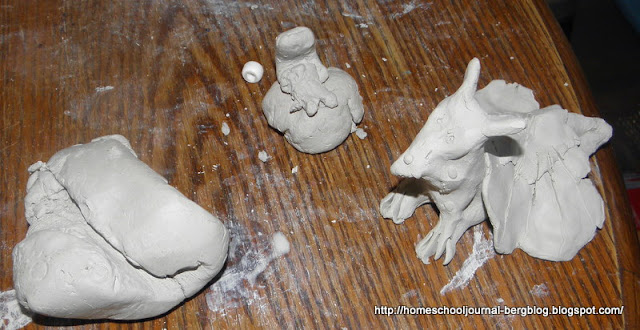The Church in the Middle Ages
We looked at the Church's influence in the Middle Ages...
Popes and Kings
Popes and Kings
The Great Schism

 |
| Gargoyles chimera |

 |
| More about how to make Gargoyles and Grotesques at Art Club Blog "The best tools to use are your fingers, for pressing, pulling and pinching the clay to form the features on your creature. Added pieces are prone to falling off. Other tools can be used later on to add details and create hollow spaces in the nostrils and mouth. Dipping your fingers in water will help to manipulate the clay if you find it drying, and will also help smooth the surface out." |
A Monk's Schedule
1:45 am - Wake Up
2:00am - Church service: singing and prayers (Matins)
3:30am - back to sleep
4:00am - church service: singing and prayers (Lauds)
5:00am - private scripture reading and prayer
6:00am - Church service, then breakfast
7:00am - Work
8:00am - Church service: singing and prayers (terce)
9:15am - work
11:45am - Church service: singing and prayers (Sixtus)
12:00pm - Midday meal
1:00pm - Private reading and prayer
1:45pm - sleep
2:45pm - Church service: singing and prayers (Nones)
3:00pm - Work
5:45pm - Meal
6:00pm - Church Service: singing and prayers (Vespers)
7:15pm - Private reading and Prayer
7:45pm - Church service: vespers
8:00pm - Bed
1:45 am - Wake Up
2:00am - Church service: singing and prayers (Matins)
3:30am - back to sleep
4:00am - church service: singing and prayers (Lauds)
5:00am - private scripture reading and prayer
6:00am - Church service, then breakfast
7:00am - Work
8:00am - Church service: singing and prayers (terce)
9:15am - work
11:45am - Church service: singing and prayers (Sixtus)
12:00pm - Midday meal
1:00pm - Private reading and prayer
1:45pm - sleep
2:45pm - Church service: singing and prayers (Nones)
3:00pm - Work
5:45pm - Meal
6:00pm - Church Service: singing and prayers (Vespers)
7:15pm - Private reading and Prayer
7:45pm - Church service: vespers
8:00pm - Bed
 |
| Saint Benedict |
 |
| Illuminated manuscripts |
 |
| Arches in Medieval Architecture (and science activity at Imagine Childhood) Welcome the arch. Do to their method of construction, arches can actually become stronger under increased pressure (in the case of the a masonry arch), but there are some important elements that make this statement true. To find out how an arch works we did this little 5 minute experiment with some cardboard arches that we cut from a standard drawing tube. First we took a singular arch and tested its strength. Easily crushed by a finger and with even more ease by a large garden brick, we observed how a single unsupported arch was in fact not very strong. Then we tried taping a few arches together to see what would happen. and they easily held up the brick! This was because the thrust of each arch was counteracted by the next keeping them from collapsing. In other words, as each arch tried to collapse and push outwards, the arch next to it was trying to do the same thing, so they ended up pushing back at each other, which in turn strengthened the structure. We then tried to add another brick, but since the ends were not supported, the additional weight caused the line of arches to push outwards and collapse. Next we tried supporting (or buttressing) the ends of the line of arches to keep them from sliding outwards and they easily held up 2 bricks since the thrust was grounded by the heavy and sturdy blocks on the ends. |





